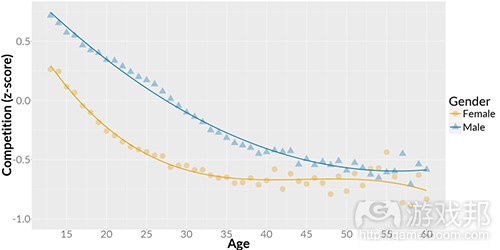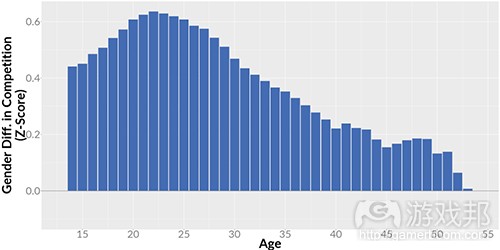从游戏竞争性吸引力的调查中学到的5个要点
作者:Nick Yee
在Quantic Foundry,我们通过“玩家动机概况调查”收集了来自23.9万玩家的数据,并让我们能够进一步去探索玩家的游戏动机是否会随着他们的性别和年龄而有所不同。当我们所面对的调查样本只有14万时我们写了一篇有关竞争和策略动机的文章。而现在拥有更大样本的我们也将拥有更加精确的判断,所以我们打算重新深入其中的竞争动机中。
1.随着年龄的下降竞争的吸引力也会随之下降
在我们模板的12种动机中,竞争的吸引力会随着年龄而下降。在我们的框架中,竞争的吸引力是来自与其他玩家的对抗,不管是在战斗,比赛或者团队间的对抗中。
尽管这些曲线并不是很直,但从相关系数中我们可以感受到效应量。就像男性玩家的相关系数是r=-.30,而女性玩家则是r=-.19
2.13岁至35岁间竞争吸引力的下降速度是最快的
比起随着年龄逐步下降,竞争的吸引力在13岁至35岁之间下降得最快。在35岁之后这种下降速度便会开始趋缓直至到达最低点。而女性往往比男性更早触及最低点,即大概早了15年。在35岁的这一标准中,我们可以发现女性已经进入凹槽处,而男性则是在50岁左右的时候才趋于平缓。
从图表中我们可以看出,在竞争设计中,比起40岁之前的任何年龄点,不管是男性还是女性在40岁与60岁之间都拥有较大且相似的玩家群组。
3.性别差异的最高点是在22岁
现在让我们专注于两种性别间的差距并根据年龄对其进行划分。尽管性别差距在35岁之前并不是很大,但其实事实并非如此。就像下面的图表所呈现的那样,性别差距的最高点是在22岁。
考虑到性别差距会随着年龄的增长而逐渐缩小,所以性别差距最主要是出现在最年轻的玩家间。为什么会这样呢?让我们进一步去寻求答案。
4.竞争吸引力最大幅度的下降是在13至20岁的女性玩家之间
我们可以基于另一种方式去看待性别的差距。我们可以研究在每个年龄中两条曲线的倾斜度。这让我们能够清楚地看到两条曲线在不同年龄间的倾斜情况。下面的图表便是男性和女性玩家曲线的斜率。
我们会发现关于竞争性的最大跌幅是出现在13至20岁的女性玩家中。这一部分的曲线比图表上其它任何一个点的下降幅度都大。
对此还有两种更广泛的解释。一方面,这可能只是男性和女性在长成成人的过程中所经历的性格改变。另一方面这可能是因为游戏文化中的一些特殊方面。例如有些在线游戏社区(特别是就竞争性的)会对女性玩家充满敌意,特别是当她们还是一些非常厉害的玩家时。而对于年轻的女性玩家来说,这些体验可能会影响着他们在竞争游戏中的乐趣(游戏邦注:或者导致更多好胜的女性玩家干脆选择离开游戏社区)。
5.最不容忽视的问题是年龄
在游戏产业和游戏社区中,我们总是花大量时间在讨论性别差距以及游戏对于女性玩家的意义。我们总是认为特定游戏动机的吸引力,特别是竞争内容的吸引力是具有明显的性别差异的。尽管这并没错,但是比起性别,年龄才是竞争吸引力的最大决定性元素。
当我们在比较22岁的男性和女性间的差距以及最年轻的男性和最年长的男性间的差距时我们便意识到了这一点。
从数据上看我们可以基于效应量去量化这种差距。在这里也就是年龄能够比性别更清楚地解释竞争性中的变量。而关于这点最让人震惊的是,当你听到人们在谈论不同玩家对于不同类型游戏的选择时,你几乎很少会听到有关年龄的内容。
机遇是显而易见的
在游戏产业中我们经常能够看到一些未经试验的假设—-不管是与游戏动机结合在一起的明确游戏类型还是关于人们如何以不同方式玩游戏的假设。而在这两种情况下我们都很难去识别真正要解决的问题并找出其实再显然不过的机遇。
(本文为游戏邦/gamerboom.com编译,拒绝任何不保留版权的转发,如需转载请联系:游戏邦)
5 Things We Learned About The Appeal of Competition From Over 239,000 Gamers
by Nick Yee
At Quantic Foundry, the data we’ve collected from over 239,000 gamers via the Gamer Motivation Profile allows us to explore how gaming motivations do and do not change with gender and age with incredible detail. Back when we had a sample size of around 140,000, we blogged about the Competition and Strategy motivations. With the larger sample size, we have much better precision especially for older gamers, and we’re going to revisit and do a deep dive into the Competition motivation.
1) The Appeal of Competition Declines The Most with Age
Across the 12 motivations in our model, the appeal of Competition declines the most with age. In our framework, Competition is the appeal of competing with other players, whether in duels, matches, or team-vs-team scenarios.
Though the curves are not strictly linear, the correlation coefficients provide a sense of the effect size. For male gamers, the correlation coefficient is r=-.30, and for female gamers it’s r=-.19.
2) The Decline in Competition is Most Rapid Between Ages 13 and 35
Instead of decreasing gradually or linearly with age, the decline in the appeal of Competition drops the most between ages 13 and 35. After age 35, this decline slows down before hitting a trough. Women hit this trough much earlier than the men, by about 15 years. At age 35, we see the women entering the trough, but the men don’t level out till around age 50. That’s right around when the gender difference in Competition largely disappears.
What the graph shows is that in terms of designing for Competition, there is a surprisingly large and similar gamer cohort of both genders between ages 40 and 60 compared with any other point before age 40.
3) The Gender Gap Peaks at Age 22
Let’s now focus on the gap between the two lines, and plot out the difference year by year. While the gender gap may appear stable before age 35, this isn’t actually the case. As the graph below shows, the gender gap doesn’t peak until age 22.
Given that the gender gap closes with age, the most natural narrative would have been that the gender gap is largest among the youngest gamers. So why isn’t this the case? Let’s dig deeper.
4) The Sharpest Drop in Competition Is Among Female Gamers Aged 13-20
We can look at the gender difference in another way. We can calculate the slopes of the two curves at each age. This lets us visualize how steep the two curves are year by year. In the graph below, we’re graphing the slope of the curves for men and women. A more negative slope means a sharper drop.
The steepest decline in Competition occurs in women between ages 13-20. This section of the curve sees a sharper drop in Competition than any other point in the rest of the graph.
There are two broad classes of explanations for this. On the one hand, this may just be how dispositions change due to biochemistry as men and women move through adolescence. On the other hand, this may be due to specific aspects of gaming culture. For example, some online gaming communities, especially competitive ones, can be hostile towards female gamers, even (or especially) when they are highly competent players. For young female gamers, these experiences may impact their enjoyment of competitive game genres (or cause more competitive female gamers to leave the gaming community altogether).
5) The Elephant in the Room is Age
In the game industry and gaming community, we spend a lot of time talking about gender differences and what games for women mean. And we tend to think that the appeal of certain gaming motivations, especially Competition, is highly gendered. While this is true, the appeal of Competition is far more strongly driven by age than gender.
We can see this when we compare the largest gap between men and women (at age 22) with the gap between the youngest and oldest men.
Statistically, we can quantify this difference with a measure of effect size. In this case, age actually explains more than double the variance in Competition than gender. What’s striking about this is that when people talk about how different gamers prefer different kinds of games, you hardly ever hear anyone talking about age.
A Quick Note About Cohort vs. Generational Differences
There’s always a risk of extrapolating longitudinally from cross-section age data. After all, there may be generational cohort effects that are separate from the effects of aging. Across the 12 motivations in our model, more than half have linear trends and almost all have monotonic curves, which is more indicative of stable age trends than the more chaotic generational changes in gaming.
Opportunities Are Hiding in Plain Sight
In the game industry, we often fixate on untested assumptions—whether this is entrenched game genres that might be combining completely orthogonal motivations as well as assumptions of how people play games differently. In both cases, we may have trouble identifying the questions we ought to be asking and finding the opportunities that are hiding in plain sight. Gain rapid insight into motivation trends and game preferences by gender and age in our data-driven 55-page Gamer Motivation Insight Report.(source:Gamasutra)
下一篇:《刺客信条:大革命》中的不连贯性











































 闽公网安备35020302001549号
闽公网安备35020302001549号